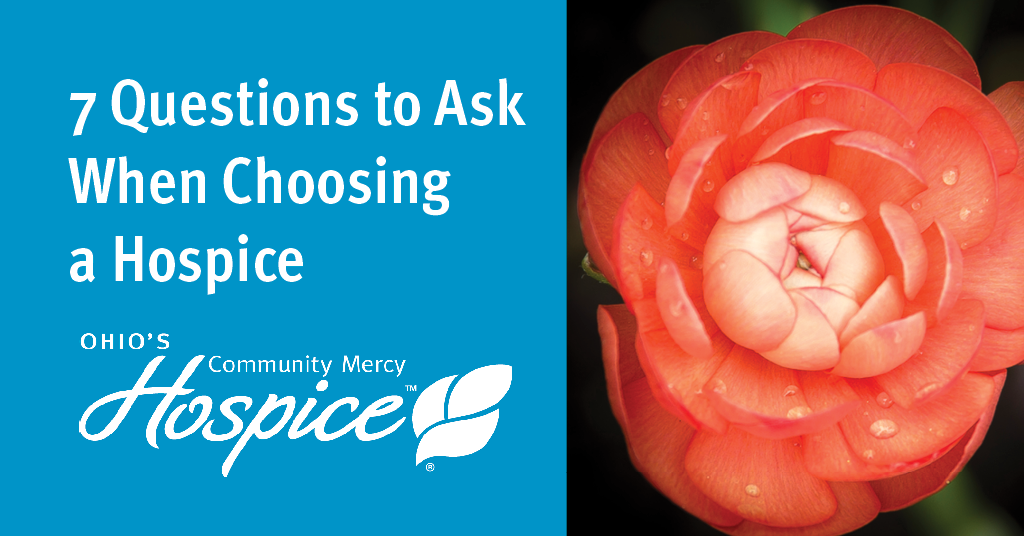
7 Questions to Ask when Considering Hospice Care
Someday you or someone you love is likely to need hospice care. Before you arrive at that day as a crisis, it’s a good idea to consider what is important in choosing who will provide your hospice care. You do have choices, and your choice is a critical factor in what services you receive. It affects not only services provided to the patient, but to those left behind. Below are important questions to ask when deciding who will provide your hospice care:
- How long has the hospice been in operation?
According to a major consumer publication, hospices with over 20 years of service demonstrate stability and reliability of service. At Ohio’s Community Mercy Hospice, our collective experience exceeds 500 years. We are a seasoned group of healthcare professionals.
2. Is the hospice Medicare-certified?
If the patient is a Medicare beneficiary and wants to use the hospice benefit, Medicare certification is required in order for costs to be covered. Ohio’s Community Mercy Hospice is certified by Medicare.
- Is the hospice accredited and state-licensed?
Hospices with Accreditation (Joint Commission or CHAP) have been reviewed by an impartial organization and accreditation indicates they are recommended as having good standards of care. Ohio’s Community Mercy Hospice is licensed by the State of Ohio and is also accredited by The Joint Commission.
- Is the hospice a not-for-profit?
Not-for profit hospices like Ohio’s Community Mercy Hospice offer patient services and support that are not required by Medicare, but are highly valuable to patient care and comfort. Because not-for-profit hospices are first committed to the hospice mission, not to shareholder profit, not-for-profit providers typically spend substantially more on patient care. Not-for-profit hospices are more likely to permit patients to continue with radiation and/or chemotherapy for cancer. If a patient wants to continue to receive these therapies to reduce the size of a tumor and reduce pain, it’s important to know whether the hospice permits such therapies.
Not-for-profit hospices also are more likely to provide an array of comfort therapies such as massage, music, art, pet assisted therapies and other non-pharmaceutical interventions that can significantly improve patient quality of life. These alternative, holistic treatments are important as you consider how well a hospice will meet patient needs.
- Is inpatient hospice care available?
Patients receiving care in their own home may develop complicated symptoms and need to have inpatient care to control symptoms or pain. Caring for someone with a serious illness can also be exhausting for caregivers, who sometimes fall ill themselves. “Respite” care can help alleviate the demands of caregiving by providing patient care in an inpatient environment to allow the caregiver a break of up to 5 days.
Ohio’s Community Mercy Hospice can provide inpatient care at Springfield Regional Medical Center or at the Hospice House of our affiliate Ohio’s Hospice of Dayton.
- Are the doctors and nurses certified in palliative care?
Specialized study in palliative and hospice care is a demonstration of expertise in addressing the needs of hospice patients. Our physicians and many of our nursing staff are certified in hospice and palliative care, assuring the highest standards of end-of-life care.
- Does the hospice offer grief support services?
Grief support services are available at no cost from some hospices, including ours, and continue for up to a year following the loss of a loved one. An array of services tailored to address the needs of various family members is a good indication of strong bereavement support for family members left behind.
Author Profile
Latest entries
 Media ReleaseJanuary 1, 2024Community Hospice to Join Ohio’s Hospice Strategic Partnership
Media ReleaseJanuary 1, 2024Community Hospice to Join Ohio’s Hospice Strategic Partnership #CelebratingLifesStoriesNovember 21, 2023Priesthood, Shelters and Hospice Care: A Life of Service for Barbara Parini
#CelebratingLifesStoriesNovember 21, 2023Priesthood, Shelters and Hospice Care: A Life of Service for Barbara Parini News and UpdatesJuly 28, 2023Ohio’s Hospice Volunteer Experiences Hospice Care as a Loved One
News and UpdatesJuly 28, 2023Ohio’s Hospice Volunteer Experiences Hospice Care as a Loved One News and UpdatesJuly 19, 2023The Not-for-Profit Difference
News and UpdatesJuly 19, 2023The Not-for-Profit Difference

